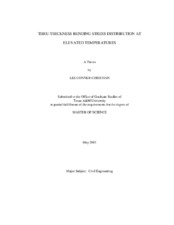| dc.description.abstract | During the bending of flange plate used for dapped girders some highway bridge
fabricators are experiencing cracking of the flange plate particularly when heat is used in
assisting the bending process. Due to the extreme strains experienced during the
fabrication process, investigating this problem requires the use of a finite element
analysis. The fabrication process was broken down into two parts, first the heating of
the plate through the use of either a furnace or an acetylene torch (thermal), and the
second was the bending process (structural). The five different temperatures collected
during the thermal analysis were a uniform temperature of 75oF, a 1100oF uniform
temperature as a result of furnace heating, both five and ten minutes of air-cooling after
the plate had reached a uniform temperature of 1100oF, and the temperature gradient
after heating the flange plate to a surface temperature of 1200oF though the use of an
acetylene torch. After the thermal analysis was completed, the resulting temperatures
were imported into the structural model. The plate thicknesses analyzed were one, one
and a half, and two inches, assuming both 50 and 70 ksi yield strengths. To achieve a 90
degree six-inch radius bend the plate was bent in five separate locations. The result of
this analysis showed that with the introduction of temperature gradients into thefabrication process, the strains along the plate??s extreme fibers increased. The model
further showed that for both a one and a half and two-inch thick plate the extreme fiber
strains exceeded ten percent, which further adds to the increased risk of the flange plate
cracking during fabrication. The highest residual stresses through the plate??s thickness
occurred during cold bending. The residual stresses through the plate??s thickness
decreased when the fabrication process was carried out at elevated temperatures. When
steel exceeds a strain of 10 to 16 percent during the fabrication process, the plate
becomes susceptible to cracking. This strain limit was exceeded for plate thicknesses of
one and a half and two inches. | en |


